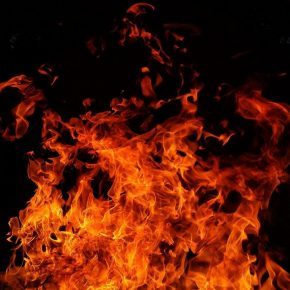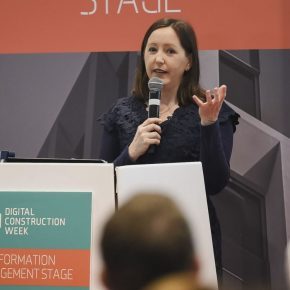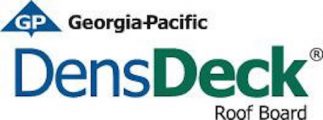
DensDeck: Why fire is a sustainability issue – the carbon cost of PV panel roof fires
Failure to prevent fire spread and penetration from PV panels can put lives at risk and undermine the sustainability of a building – the words of Ieuan Compton – International Strategic Marketing Manager on behalf of Georgia-Pacific, who writes this article…
Buildings and construction are responsible for around 37% of global greenhouse gases. Traditionally, reducing a building’s carbon footprint meant reducing operational carbon emissions – the CO2 generated when a building is in use. In recent years, this has widened to encompass reductions in the embodied carbon of buildings. That is the total carbon generated throughout a building’s lifecycle. This includes everything from the extraction of raw building materials, manufacturing and transportation of products to site, through to what happens to those materials at the end of the building’s life.
Building sustainability accreditation schemes now include targets for reducing carbon from materials and resources used in a building’s construction and maintenance. This runs alongside other operational sustainability measures such as the deployment of renewable energy. There is, however, another factor that potentially needs to be considered when looking at building sustainability, and that’s fire.
Fire performance as a measure of safety and sustainability
Considering fire as a measure of sustainability is a relatively new concept. Traditionally, fire has understandably been viewed purely as a safety issue. As we have seen in too many devastating incidents around the globe, fire and the resulting toxic smoke can lead to injury and death.
The primary issue when considering fire in buildings in any stage of building planning, specification and construction is to preserve life. Once that’s been done, however, it’s also critical to consider the impact of fire from an economic, environmental and social perspective.
Buildings with a lifespan of 30 to 50 years are likely to be exposed to some form of fire risk during that time. Take datacentres, and datacentre flat roof systems specifically, as an example. Many datacentres now incorporate PV panel flat roofs as part of their sustainability strategies to help reduce carbon emissions and reliance on the local grid. While this makes good commercial sense, installing any electrical equipment automatically increases the risk of fire on a roof. In the case of PV panels, this risk is due to high voltage arching that can cause combustible materials such as the waterproof layer to ignite.
Recent research into PV panel arcing by Dr KT Tan, Professor Grunde Jomaas and FRISSBE included a fire test on a rig which replicated a realistic retrofit roof build up solution with installed PV panels. The test showed that both bitumen and EPDM waterproof membranes tested on the rig were completely consumed by fire in less than half an hour.
Furthermore, the analysis [1] puts the annual fire incident rate at 28.9 fires per GW of PV panel generation capacity. This means that if the PV panel deployment remains in 2025, there will be an estimated 150 roof-top fires caused by PV panels in the UK. If projected PV panel growth rates are realised, this figure could grow to up to two million fires globally by 2050. When you consider the number of PV panels installed globally, the number of PV panel fires could be huge.
How fire affects sustainability
If a fire breaks out and propagates throughout the building, large quantities of CO2, which causes global warming, are released into the atmosphere, as well as other toxic gasses and chemicals, such as carbon monoxide (CO), hydrogen cyanide (HCN), hydrogen chloride (HCl), nitrogen oxide and dioxide (NO & NO2).
Quelling the fire uses precious natural resources – a PV panel fire at We The Curious, a science and education charity in Bristol, England took thousands of litres of water to extinguish the flames, causing huge water damage to the property, leading to a two-year closure. The water run-off also has the potential to pollute groundwater and surrounding land.
A prime example of environmental pollution is that caused by the Grenfell fire in London, England. Sixteen months after the fire, soil samples taken 140m from the site were found to have a range of toxins, including the carcinogenic chemical benzene, at levels 40 times higher than are typical for the area.
Chemicals aren’t the only issue. Following a fire at a warehouse in Heerenveen, Netherlands involving 2,000 PV panels, sharp fragments from the panels were spread over several kilometres, leading to calls for farmers to bring livestock indoors. The warehouse itself was completely destroyed, owing in part to the difficulty in extinguishing multiple small PV panel fires that burned over 24 hours.
Once a fire has been extinguished, if a building hasn’t been destroyed, it may still be deemed unsafe and need to be demolished, or it will need to be repaired and refurbished. In most cases, damaged construction materials, furniture and possessions will be sent to landfill. In addition to the economic cost and business disruption, there’s the impact on staff from losing their possessions, place of work and, possibly, employment.
Finally, there’s the astronomical carbon impact of demolition, waste disposal and rebuild. A prime example is Derby Assembly Rooms in England, which has not been used since 2014 when a fire in the adjacent car park damaged its plant room. Analysis by Philip Oldfield, director of the architecture programme at the University of New South Wales Sydney, Australia showed that knocking down the structure and rebuilding a similar sized building would result in 11,400 tonnes of CO2 – something that’s hardly sustainable and led to widespread criticism.
How fire resiliency can be improved in flat roofs
When designing buildings for safety and sustainability, the focus must be on fire prevention and containment. In England, Approved Document Part B which governs fire safety has been strengthened. As a result, the use of combustible materials is prohibited in all external wall systems over 18m high and curtain wall systems, such as rainscreen façades, between 11 and 18m in height. Currently, however, combustible materials can still be used in roof build-ups, regardless of the building’s height, so the specifier must assess the fire risk.
While PV panels are a tried and tested technology, it must be recognised that whenever electrical equipment is installed, it brings with it an increased risk of fire. If a fire does break out, it’s much safer – and far more sustainable – if it can be contained to a small area of a roof and extinguished before it has spread and penetrated through the build-up, putting the building, its occupants and contents at risk.
To reduce this risk, it is important to ensure the roof build-up has a high degree of fire resiliency, ergo, is designed to slow fire spread and penetration. One way to increase the fire performance of roofs designed to house PV panels is to use non-combustible materials as much as possible and install cover boards above the insulation layer and below the waterproofing layer to help slow the spread of fire.
If a fire starts on the roof, the presence of a fire resistant cover board can help reduce the rate of fire spread across the surface of the waterproofing layer. It also helps increase the fire resistance of the roof build-up, slowing down the rate of fire penetration into the building below. As a result, installing a cover board within the roof build-up can help increase the amount of time available to extinguish a fire, limiting the likely damage, financial loss to a business and the additional embodied carbon accrued through repair and refurbishment.
When it comes to cover boards, the two types most commonly used to help increase the fire performance of roof build-up are cementitious and gypsum core cover boards. As with any material, it’s important to specify a coverboard rated non-combustible with a Euroclass A1 reaction to fire classification. An A1 classification demonstrates the materials will not fuel a fire, and will help to prevent its spread.
The easiest way to ensure the resilience of the roof and therefore, its long-term sustainability is to choose a roof assembly with a roof cover board that is certified as ‘FM approved’ by FM (formerly FM Global). There are currently more than 700,000 roof assemblies that include a roof cover board on the assemblies in RoofNav, FM’s roof assembly database, of which, over 53% feature DensDeck® Roof Boards, DensDeck ® Prime Roof Board or DensDeck ® StormX Prime Roof Board.
Building sustainability is not just limited to the use of materials and resources now, it also carries the responsibility to ensure that buildings can deliver a lifetime of service. This means that fire performance should go beyond legislative compliance and be considered as a measure of sustainability. If you are incorporating PV panels as part of your datacentre’s sustainability strategy, then you should also consider if the roof is designed to prevent the spread and penetration of fire. And an effective way to do that is to incorporate a DensDeck® Roof Board as part of the build-up.”
For more information, download the whitepaper ‘Commercial PV panel roofs; Risk factors and their mitigation through resilient roof design’
Source
[1] Experimental Study of the Fire Dynamics in a Semi-enclosure Formed by Photovoltaic (PV) Installations on Flat Roof Constructions – Journal of Building Engineering 28 March 2022
Georgia-Pacific Building Products
133 Peachtree Street, NE, Atlanta
GA 30303
(USA) 1-800-225-6119
Visit Supplier's page
Latest news

30th April 2025
Digital Construction Week announces seminar programme for its landmark 10th edition
Digital Construction Week (DCW) returns to ExCeL London on 4 – 5 June 2025 with its most impactful programme yet. It brings together the best and brightest from across AECO, for two days of practical learning and idea sharing.
Posted in Articles, Building Industry Events, Building Industry News, Building Products & Structures, Building Services, Building Systems, Exhibitions and Conferences, Information Technology, news, Restoration & Refurbishment, Retrofit & Renovation, Seminars
29th April 2025
Senior pledges to ‘bee’ part of the solution with new biodiversity initiative
Senior Architectural Systems has installed its first on-site beehive, marking another step forward in its commitment to sustainability and biodiversity.
Posted in Articles, Building Industry News, Building Products & Structures, Building Services, Curtain Walling, Doors, Glass, Glazing, Innovations & New Products, news, Restoration & Refurbishment, Retrofit & Renovation, Sustainability & Energy Efficiency, Walls, Windows
29th April 2025
West Fraser range delivering key benefits for South-East carpentry company
An experienced carpenter and building site manager who has recently set up his own company is using high performance panel products from the West Fraser range.
Posted in Articles, Building Industry News, Building Products & Structures, Building Systems, Case Studies, Garden, Restoration & Refurbishment, Retrofit & Renovation, Sustainability & Energy Efficiency, Timber Buildings and Timber Products
29th April 2025
CPD Courses Available Online From Ecological Building Systems
Ecological Building Systems, a leading supplier of natural building products for sustainable construction, has revealed its comprehensive CPD programme for the year ahead.
Posted in Articles, Building Industry Events, Building Industry News, Building Products & Structures, Building Services, Continuing Professional Development (CPD's), Information Technology, Innovations & New Products, Insulation, Restoration & Refurbishment, Retrofit & Renovation, Seminars, Sustainability & Energy Efficiency, Training, Walls, Waste Management & Recycling
 Sign up:
Sign up: 